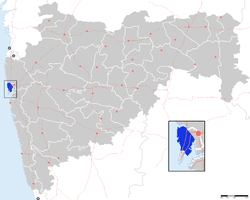Mumbai Suburban district
Mumbai Suburban District is a district of Maharashtra in Konkan Division. Its headquarters is in Bandra. It consists of three administrative subdivisions : Kurla, Andheri, and Borivali.[1] The district along with Mumbai City district and other suburban localities make up Greater Mumbai on Salsette Island. The district occupies an area of 446 km².[2]
Mumbai Suburban district | |
|---|---|
District of Maharashtra | |
 Location of Mumbai Suburban district in Maharashtra | |
| Country | |
| State | Maharashtra |
| Division | Konkan Division |
| Headquarters | Bandra |
| Tehsils | 1. Kurla, 2. Andheri, 3. Borivali, |
| Government | |
| • Lok Sabha constituencies | 1. Mumbai North, 2. Mumbai North West 3. Mumbai North East 4. Mumbai North Central, 5. Mumbai South Central (shared with Mumbai City district) |
| • Vidhan Sabha constituencies | 26 |
| Area | |
| • Total | 446 km2 (172 sq mi) |
| Population (2011) | |
| • Total | 9,356,962 |
| • Density | 21,000/km2 (54,000/sq mi) |
| Time zone | UTC+05:30 (IST) |
| Major highways | NH-3, NH-8, |
| Website | https://mumbaisuburban.gov.in/ |
This is the second smallest district of Maharashtra, and it administratively comes under Konkan Division.
The jurisdiction of Mumbai Suburban District is from Bandra to Dahisar, from Kurla to Mulund and from Kurla up to Trombay Creek.
Mumbai Suburban District is one of the largest districts in the country by population. The current population is 9,356,962, according to the 2011 census, making it the fifth most populous district in India (out of 672).[3] The Mithi River is the main river in the district.
History
Mumbai Suburban district was created on 1 October 1990 when Greater Mumbai bifurcated into Mumbai City and Mumbai Suburban district.[4]
Geography
Many important places have adorned the beauty of this district, including Mount Mary Church, Jogeshwari Caves, Mahakali Caves, Essel World, Water Kingdom, Marve Beach, Aksa Beach, Madh Island, Malwani, Sanjay Gandhi National Park, Aarey Colony, Kanheri Caves, Film City, Tulsi Lake, Vihar Lake and Powai Lake.
Climate
| Mumbai | ||||||||||||||||||||||||||||||||||||||||||||||||||||||||||||
|---|---|---|---|---|---|---|---|---|---|---|---|---|---|---|---|---|---|---|---|---|---|---|---|---|---|---|---|---|---|---|---|---|---|---|---|---|---|---|---|---|---|---|---|---|---|---|---|---|---|---|---|---|---|---|---|---|---|---|---|---|
| Climate chart (explanation) | ||||||||||||||||||||||||||||||||||||||||||||||||||||||||||||
| ||||||||||||||||||||||||||||||||||||||||||||||||||||||||||||
| ||||||||||||||||||||||||||||||||||||||||||||||||||||||||||||
Demographics
| Year | Pop. | ±% p.a. |
|---|---|---|
| 1901 | 206,218 | — |
| 1911 | 255,276 | +2.16% |
| 1921 | 306,763 | +1.85% |
| 1931 | 310,621 | +0.13% |
| 1941 | 400,297 | +2.57% |
| 1951 | 665,424 | +5.21% |
| 1961 | 1,380,123 | +7.57% |
| 1971 | 2,900,197 | +7.71% |
| 1981 | 4,958,365 | +5.51% |
| 1991 | 6,751,002 | +3.13% |
| 2001 | 8,640,419 | +2.50% |
| 2011 | 9,356,962 | +0.80% |
| source:[5] | ||
According to the 2011 census, Mumbai Suburban district has a population of 9,356,962,[3] roughly equal to the nation of Benin[6] or the US state of North Carolina.[7] This gives it a ranking of 5th in India (out of a total of 640).[3] The district has a population density of 25,291.28 inhabitants per square kilometre (65,504.1/sq mi).[3] Its population growth rate over the decade 2001-2011 was 8.01%.[3] Mumbai Suburban has a sex ratio of 857 females for every 1000 males,[3] and a literacy rate of 90.9%.[3]
At the time of the 2011 Census of India, 35.22% of the population in the district spoke Marathi, 29.57% Hindi, 11.52% Gujarati, 11.13% Urdu, 2.18% Tamil, 1.77% Sindhi, 1.63% Konkani, 1.39% Telugu, 1.15% Malayalam, 1.08% Bengali, 0.93% Punjabi, 0.62% Tulu, 0.58% English and 0.46% Odia as their first language.[8]
See also
References
- "Mumbai Suburban District". Mumbaisuburban.gov.in. Retrieved 1 September 2010.
- Mumbai Suburban Official Website. Retrieved 28 April 2008.
- "District Census 2011". Census2011.co.in. 2011. Retrieved 30 September 2011.
- "District Profile". mumbaisuburban.gov.in. Archived from the original on 2 December 2014. Retrieved 28 June 2015.
- Decadal Variation In Population Since 1901
- US Directorate of Intelligence. "Country Comparison:Population". Retrieved 1 October 2011.
Benin 9,325,032
- "2010 Resident Population Data". U. S. Census Bureau. Retrieved 30 September 2011.
North Carolina 9,535,483
- 2011 Census of India, Population By Mother Tongue
External links
| Wikimedia Commons has media related to Mumbai Suburban district. |